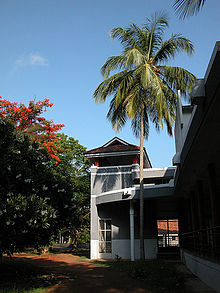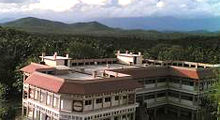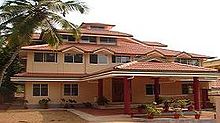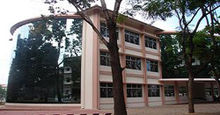- National Institute of Technology Calicut
-
National Institute of Technology Calicut 
Motto Tamaso Ma Jyotirgamaya Motto in English From darkness, Lead us unto Light Established 1961 Type Institute of National Importance Academic staff 150 Undergraduates 3500 Postgraduates 700 Location Calicut, Kerala, India
11°19′19″N 75°56′07″E / 11.321973°N 75.935386°ECoordinates: 11°19′19″N 75°56′07″E / 11.321973°N 75.935386°ECampus 420 acres (1.7 km2), rural/semi-urban Director M. N. Bandyopadhyay[1] Website www.nitc.ac.in The National Institute of Technology Calicut (Malayalam: നാഷണൽ ഇൻസ്റ്റിറ്റ്യൂട്ട് ഓഫ് ടെക്നോളജി കാലിക്കറ്റ്, Hindi: राष्ट्रीय प्रौद्योगिकी संस्थान कालिकट; NITC) is a federally funded technical university and an institute of national importance governed by an act passed by the Parliament of India. The campus is situated 22 km north-east of Kozhikode (Calicut) city on the Calicut – Mukkam Road.[2] It was established in 1961 and was known as Calicut Regional Engineering College (CREC) until 2002. It is one of the National Institutes of Technology established by the Government of India for imparting technical education to students from all over the country. The college is among the very few institutions in the country to host a Supercomputer of its own.[3]
Contents
History
Initial years
NITC was set up in 1961 as Regional Engineering College, Calicut (CREC) as the ninth of its kind and the first one to be established during the Third Five-Year Plan period. Until the formation of Calicut University in 1963, the institute was affiliated with Kerala University. It was largely due to the efforts of Pattom Thanu Pillai, then Chief Minister of Kerala, that the institute came into being. Prof. S. Rajaraman, first principal of Government Engineering College, Thrissur was appointed as the special officer in 1961 to organise the activities of the college until Dr. M. V. Keasva Rao took charge as the first principal of the college. The classes were initially held at the Government Polytechnic at West Hill, Calicut before it moved to its present campus in 1963. The college started with an annual intake of 125 students for the undergraduate courses, on a campus of 120 acres (0.49 km2).
Expansion
The intake for the undergraduate courses was increased to 250 in 1966, 150 for the first year and 100 for the preparatory course. The annual intake was reduced from 250 to 200 from the year 1968–69 on account of industrial recession.
After Prof S. Unnikrishnan Pillai took charge as principal in 1983, the Training and Placement Department was started to organise campus recruitments for students. The college moved into the area of Information Technology in 1984 with the commissioning of multi-user PSI Omni system and HCL workhorse PCs. In 1987 the college celebrated 25 years of its existence, and postgraduate courses were started. The CEDTI was established on the campus the following year.
In 1990 Shankar Dayal Sharma inaugurated the Architecture Department Block and construction of a computer centre was completed. In 1996, the institute website (the first in Kerala) was launched. The Indian Institute of Management Kozhikode functioned from the NIT Calicut campus in its first few years of existence before moving to its new campus in Kunnamangalam in 2003.
Recent developments
The Ministry of Human Resource Development, Government of India, accorded NIT status to REC Calicut in June 2002 granting it academic and administrative autonomy. It was a lead institute under the World Bank-funded Technical Education Quality Improvement Program (TEQIP) which began in 2002. In 2003, students were first admitted to the flagship undergraduate B.Tech through the All India Engineering Entrance Exam. With the passing of the National Institutes of Technology Act in May 2007, NIT Calicut was declared an Institute of National Importance.[4] The National Institutes of Technology Act is the second legislation for technical education institutions after the Indian Institutes of Technology Act of 1961. In 2007 NIT Calicut raised its annual intake for its undergraduate program to 570.[5]
Departments and Academics
Engineering departments
- Department of Architecture
- Civil Engineering Department
- Computer Science and Engineering Department
- Department of Chemical Engineering
- Electrical Engineering Department
- Electronics and Communication Engineering Department
- Mechanical Engineering Department
School of Natural Sciences
- Department of Chemistry
- Department of Mathematics
- Department of Physics
Schools
- School of Management Studies
- School of Biotechnology
- School of Nano Science and Technology
Centres
- Centre for Biomechanics
- Centre for Information Technology and Communication
- Sophisticated Instruments Centre
- Centre for Value Education
- NITC IBM ACE Centre
- Centre for Continuing Education
- Campus Networking Centre
Allied department
- Department of Training and Placement
Courses
Undergraduate course offered by NITC include Bachelor of Technology (B.Tech.) in various engineering fields and Bachelor of Architecture (B.Arch.). These are paralleled by postgraduate courses offering Master of Technology (M.Tech.) and Master of Architecture (M.Arch.). In addition, NITC offers an applied computer science course granting Master of Computer Application (M.C.A.), a business course granting Master of Business Administration (M.B.A.) and a three year Master of Science (Technology) (M.Sc.(Tech.)). Ph.D. programmes are available on all engineering and science disciplines.
School of Management Studies
The School of Management Studies offers a two-year Master of Business (MBA) program for graduates in Engineering, and a Ph.D. program in various domains of management. The admission to the MBA program is based on CAT scores, performance in group discussions and interviews.
IT Finishing School
The Union Ministry of Human Resource Development, has started IT finishing schools at NIT Calicut and seven other national institutions: the Indian Institute of Technology (IIT), Roorkee, and the National Institutes of Technology (NITs) at Durgapur, Kurushetra, Jaipur, Surathkal, Trichy and Warangal. This school is supportd by NASSCOM and some of the major IT companies in India.[6]
International Liaison Office
The institute has set up an International Liaison Office to follow up the MoUs (Memorandum of Understanding) signed between NITC and other institutions in the world. It also guides current students from abroad and those interested in joining the institute.
Academic Quality Management Initiatives
The institute has initiated an academic audit of all the programmes conducted based on a format prepared at a National Workshop on Academic Quality Management in which experts on technical education from IITs and other universities gave presentations. Academic audit has been conducted successfully during 2009 and 2010. A teacher evaluation by students has been place for the last several years and has been made online.
Facilities
Hostels
NITC is a fully residential institution with 12 hostels on the campus to accommodate students. The boys' hostels are named by letters A, B, C, D, E, F, F', G, PG I, PG II, and three girls' hostels (LH). A, B, and C hostels have triple rooms but accommodate four or five students per room due to increase in intake of students and shortage of hostel facilities. D, E, F, G, PG I, and PG II are single-seated but, due to high intake of students, some rooms are being used as doubles.
A and PG I hostels accommodate I year B.Tech students. II year B.Tech students are accommodated in the B, G and PG II hostels. III year B.Tech students are accommodated in C and G hostel. Final year B.Tech students are accommodated in D, E and F hostels. M.Tech. and MCA students reside in apartments.
The boys' hostels are close to the academic area, while girls' hostels are in the residential campus. There are around 2200 students in NITC hostels. A mini-canteen is available in the hostel premises. STD/ISD facilities are available in almost all hostels.
Each hostel contains its own mess, and students are allowed to join the mess of any hostel. The type of food served in the hostel messes are as follows:
- Cosmopolitan: A, PG I
- Vegetarian: C, E (North Indian), F (North Indian)
- Non-vegetarian: B, G, D, PG II (Kerala)
B mess is managed by the students under the supervision of the Students Affairs Council.
There is an extension counter of the NITC Multipurpose Co-operative Society in A and D hostels. Students are permitted to use their own computers in their rooms. All hostels except A have their own LAN but hostels are not interconnected. Each hostel contains a common room with cable TV.
There are three hostels in NIT Calicut to accommodate female undergraduate, postgraduate and Ph.D. programme students. Two cosmopolitan messes are available in the girls' hostel premises. Other facilities like mini-canteen, indoor shuttle court, gymnasium, and Cooperative Store Extension Counter are available in the girls' hostel.
Sports
NITC has a gymnasium, swimming pool, an open air theatre, an auditorium and facilities for outdoor sports like tennis, football, volleyball, badminton, roller skating, hockey and basketball. It also has a cricket ground where Ranji Trophy matches have been played.[7]
Central Library
NITC's Central Library, with more than 100,000 books, is one of the largest technical libraries in India. It subscribes to more than 200 print journals. The institute has a digital library, Nalanda (Network of Automated Library and Archives), which houses online resources. Users of the institute and networked institutions can access around 17,000 journals, proceedings, databases, electronic theses, dissertations and online courses at Nalanda. It is part of the Indest consortium, which networks the libraries at technical institutions in India.
NIT Calicut's supercomputer, Purna (Parallel Universal Remote Numerical Analyser), is accessible from anywhere in the campus and is provided for the use of all students and faculty members. PURNA has a peak speed of 1.5 Tera Flops.[3]
Technology Business Incubator
The Technology Business Incubator (TBI) at NIT Calicut was set up with the help of the Department of Science and Technology, Government of India and the National Science and Technology Entrepreneurship Development Board (NSTEDB). Its objective is to help the development of start-up ventures in electronics and IT.[8][9]
Culture and student life
NIT Calicut holds two major annual events, the techno-management festival Tathva, held in the monsoon semester and the cultural festival Ragam, which is held in the winter semester.
Tathva
Main article: TathvaTathva is the annual techno-management fest organized by NITC. It is usually held during the month of September and lasts for four days. Tathva has come to be regarded as one among the biggest technical festivals of South India. It has been held every year since its inception in 2001. Aimed at inspiring innovation and technical interest among students and awareness among the public, Tathva has played host to lectures, seminars, workshops by companies like ParaMek Technologies, competitions, paper presentations, exhibitions, quizzes, model displays and robotics events. Dr. A.P.J. Abdul Kalam, Dr. G. Madhavan Nair, Dr. Harold Kroto, Dr. Johans Orphal, Dr. Jimmy Wales (founder of Wikipedia), Suhas Gopinath, were some of the eminent guests of the previous editions of Tathva.
Ragam
Main article: Ragam (festival)Ragam is the cultural festival of NITC. Colleges and universities all over Kerala and outside the state compete with each other in events such as trivia quizzes, dance competitions, rock shows and music concerts. Some of the performers who have performed in previous years include Shaan, Shankar Mahadevan, Kartik, Benny Dayal, and Parikrama. 'Breathe Floyd' a Pink Floyd tribute band from the UK performed during Ragam 2009. Ragam 2010 featured KK, Naresh Iyer and "Higher On Maiden" a tribute band to Iron Maiden.
Ragam is held in the memory of the former student P. Rajan. He died after being held (ostensibly for being a Naxalite) in police custody.[10]
Student organizations
The student organizations at NITC include The Industrial and Planning Forum (IPF), Club Unwired (Radio-controlled modelling), the Indian Society for Technical Education (ISTE) Students' Chapter, Club Mathematica, Literary and Debating Club, The Forum for Dance and Dramatics, Enquire (the NITC Quiz Club), the Nature Club and the Indian Cultural Association.
Professional bodies with student chapters include the Computer Society of India, the Indian Society for Technical Education, Institute of Electrical and Electronics Engineers (IEEE) and The Institution of Engineers (India).
Admissions
Students are taken in for the undergraduate courses through the All India Engineering Entrance Exam (AIEEE) conducted by CBSE, New Delhi. Around one million students wrote this test in 2009 to gain admission to one of 20 NITs. This makes it one of the largest such examinations in the world.[11] Admission to some other autonomous national level technical institutes (called Deemed University) is also through AIEEE.
Admission to the graduate M.Tech and PhD courses are primarily based on scores in the GATE exam, conducted by the IITs. Admission to the MCA programme is done through the NIMCET conducted by the NITs. The first NIMCET in 2006 was conducted by NIT Calicut. Faculty from other institutes work as research scholars in NITC under the Quality Improvement Programme (QIP). It is the national coordination centre for the QIP of polytechnic institutes.
Administration
Under the constitution of the National Institutes of Technology Act 2007, the President of India is the Visitor to the institute. The authorities of the institute are Board of Governors and the Senate. The Board is headed by the Chairman, who is appointed by the Visitor. The Director, who is the secretary of the Board, looks after the day-to-day running of the institute. The Board of Governors has nominees of the Central Government, the State Government, the NIT Council and the Institute Senate.
Rankings
NITC was ranked 23 in the India Today Best Engineering colleges 2011.[12] It was not ranked on the Dataquest Top Engineering Colleges in India of 2010.[13] In the 2009 edition it ranked 16.[14] NITC was not ranked in the Outlook India Top Engineering Colleges of 2011[15] and did not participate in the 2010 edition either.[16] In 2009 it ranked 32.[17]
NITC people
Chairpersons
- P. Rama Rao (2001–2005)
- S. C. Tripathi (2005–)
Principals/directors
- M. V. Kesava Rao (1961–1969)
- K.M. Bahauddin (1969–1980)
- P. K. Charlu (acting 1980–1983)
- S. Unnikrishna Pillai (1983–1996)
- M.P. Chandrasekharan (1996–2003)
- S.S. Gokhale (2003–2004)
- B.N. Nagaraj (acting 2004–2005)
- K.N. Dutta (acting 2005)
- G.R.C. Reddy (2005–2010)
- E. Gopinathan (acting 2010–2011)
- T. L. Jose (acting 2011)
- Sandeep Sancheti (Director NITK Surathkal as acting director in 2011)
- M. N. Bandyopadhyay (2011-)
Notable alumni
- Jishnu, Malayalam film actor[citation needed]
- Prabhakaran Paleri, scholar in national security studies, former Head, School of Management Studies, NIT Calicut[citation needed]
References
- ^ Director @ NIT Calicut
- ^ [www.optics.nitc.ac.in/LOCATION.html LOCATION – National Institute of Technology Calicut]
- ^ a b Super Computing Facility at NITC
- ^ "National Institutes of Technology Bill" (PDF). http://www.prsindia.org/docs/bills/1167468390/1167468390_1161330652_national_institute_of_technology.pdf.
- ^ Bablu, J.S. "Looking for the NIT Advantage", The Hindu, June 19, 2007. Accessed July 10, 2007.
- ^ "IT Finishing School". The Hindu (Chennai, India). 2007-04-03. http://www.hindu.com/thehindu/edu/2007/04/03/stories/2007040300030100.htm. Retrieved 2007-05-09.
- ^ "Regional Engineering College Cricket Ground". http://content-usa.cricinfo.com/india/content/ground/58257.html. Retrieved 2006-10-06.
- ^ "Technology Business Incubators (TBIs) in India". http://www.nstedb.com/institutional/tbi.htm. Retrieved 2007-01-22.
- ^ "Spinning success stories in entrepreneurship". http://www.hinduonnet.com/2004/06/01/stories/2004060109070500.htm. Retrieved 2007-01-22.
- ^ "Ragam at NIT Calicut". The Hindu (Chennai, India). 2006-02-23. http://www.hindu.com/2006/02/23/stories/2006022307230300.htm. Retrieved 2007-01-10.
- ^ "All India Engineering Entrance Exam". The Hindu (Chennai, India). http://www.hindu.com/2007/04/29/stories/2007042914810400.htm. Retrieved 2007-01-22.
- ^ "Best Engineering colleges 2011". India Today. http://indiatoday.intoday.in/specials/bestcolleges/2011/ranks.jsp?ST=Engineering&Y=2011. Retrieved 11 July 2011.
- ^ "Dataquest Top Engineering Colleges in India". dqindia.ciol.com. Dataquest. February 18, 2011. http://dqindia.ciol.com/content/top_stories/2011/111021801.asp. Retrieved 9 September 2011.
- ^ Priya Kekre (December 22, 2009). "Dataquest : Top Stories : Temples of Modern India". dqindia.ciol.com. Dataquest. http://dqindia.ciol.com/content/top_stories/2009/109122203.asp. Retrieved 13 September 2011.
- ^ "Top Engineering Colleges". Outlook India. Jun 28, 2011. http://www.outlookindia.com/article.aspx?277249. Retrieved 2011-06-22.
- ^ "Top 50 Engineering Colleges". Outlook India. Juun 28, 2010. http://www.outlookindia.com/article.aspx?265887. Retrieved 2011-06-19.
- ^ "Top 75 Engineering Colleges". Outlook India. http://www.outlookindia.com/article.aspx?250245. Retrieved 2011-03-02.
External links
National Institutes of Technology (NITs) Institutes About Schools of Management Techfests Culfests Bizfests NIT Calicut • Calicut Medical College • IIM Kozhikode • MCC Calicut • Govt. Law College • Farook College • Guruvayurappan College • Devagiri College • Govt. Homoeopathic Medical College • College of Nursing, Calicut • Kerala School of Mathematics, KozhikodeUniversities in Kerala Amrita Vishwa Vidyapeetham • Central University of Kerala • Cochin University of Science and Technology • Indian Institute of Management Kozhikode • Indian Institute of Science Education and Research, Thiruvananthapuram • Indian Institute of Space Science and Technology • Kannur University • Kerala Agricultural University • Kerala Kalamandalam • Kerala University of Fisheries and Ocean Studies • Kerala University of Health Sciences • Kerala Veterinary and Animal Sciences University • Mahatma Gandhi University • National Institute of Fashion Technology Cannanore • National Institute of Technology Calicut • National University of Advanced Legal Studies • Sree Chitra Thirunal Institute of Medical Sciences and Technology • Sree Sankaracharya University of Sanskrit • University of Calicut • University of KeralaCategories:- Educational institutions established in 1961
- Engineering colleges in Kerala
- National Institutes of Technology
- Deemed Universities in India
- Education in Kozhikode
Wikimedia Foundation. 2010.







